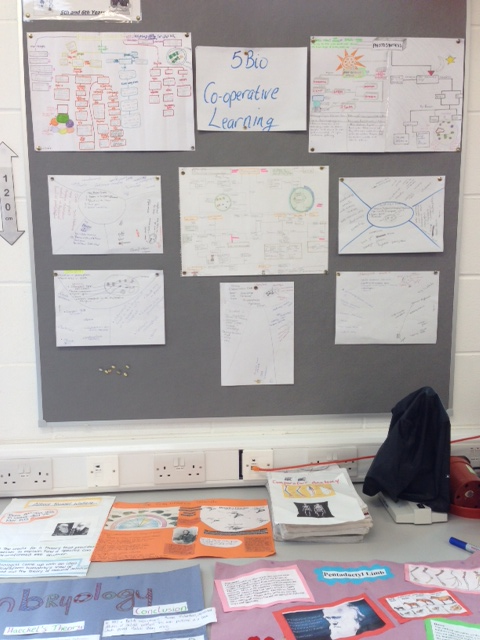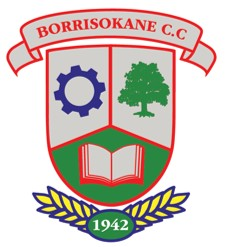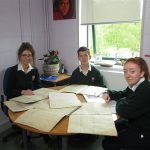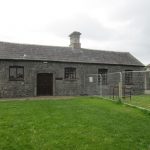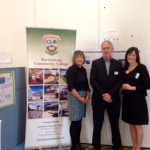Spotlite
Students and Teachers work together to highlight, understand and deliver a shared model of highly effective practice in learning and teaching
Students visit lessons other than their own and they:
- observe
- take notes
- collaborate with the teacher after class and at group meeting
Key agreed recommendations are shared and adopted by staff
Process:
- Inform teachers of initiative and ask for volunteers
- Identify students to be part of initiative by speaking to year heads
- Speak to nominated students and explain the process
- Have a group meeting with students, teachers and T&L Committee
- Explain the observation sheet and identify the 6 categories
- Create a timetable
- Have a review meeting with everyone once the observations have been completed
- Feedback to whole school at staff meeting
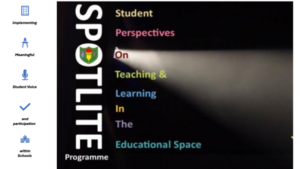
Teach Meet:
Groups of teachers meet to discuss strategies and resources in relation to Teaching and Learning and our School Self Evaluation targets e.g. digital technologies, formative feedback, differentiation etc. Strategies are shared and discussed amongst the group and compiled for whole staff sharing purposes. This ensures that effective & highly effectives practices are shared school wide.

Erasmus FICTION Project – involving schools in Ireland, Sweden and Italy.
The FICTION project identifies science subjects as good examples where digital tools can increase students’ understanding by visualizing abstract models and theories. For this purpose, the further development of teachers’ digital competence is the most important need to be addressed.
For details on the project Click Here.
NAPD Creative Engagement Project
A heritage committee comprising of current and retired teaching staff, the school secretary and the Deputy principal was set up in August 2015. Its objective was to initiate a heritage project that would highlight the three historic workhouse buildings that house the school, the sports complex and the canteen. The third and last workhouse is being currently renovated and when completed in September 2017 will boast a games room, library, resource rooms and extra classrooms. The committee hopes to encourage students through various subjects to complete research projects on the history of education using all the available archived historic documents including school rolls and minutes from all Board meetings since 1942. The committee applied successfully for a grant in October 2015 from the NAPD under the Creative engagement project.
Student engagement in this project since September 2015 has been achieved through Maths, Irish, Computers, Woodwork, History and Art. A group of students spent weeks trawling through old school rolls identifying subjects that were taught when the school was first established in 1942. They translated the records from Irish and were fascinated to discover that subjects students studied at the time included typing, sewing, laundry and bird watching. For many students the rolls include names of many of their relatives including parents and grandparents. A group of TY maths students analysed all enrolments into 1st year since 1950. They represented the data in graphical format. They also investigated and compared numbers of girls and boys that enrolled. The school principal has organised that all students and teachers can access the Irish Newspapers Archives on line dating back to 1700’s. Future plans for student group projects over the next few months include the painting of a mural on the stairway in the school. The Art teacher, a member of the committee, will oversee the painting of a mural depicting an aspect of the old Irish workhouse by the students. Advice and guidance may also be sought from an external and local artist. Woodwork students will create timber signs for display on all the historic buildings on site including the three workhouses, the laundry room, the bakery, the dormitories and the graveyards. One leaving cert history student wrote a moving and emotive piece of creative writing depicting life in the workhouse written from a mother’s perspective. This will be framed and displayed on the school wall. Students are starting to prepare a presentation of their work for the Creative Engagement exhibition by all schools of their projects in the IMMA in Dublin in October 2016.
The committee will purchase 6 large glass frames and a cabinet to display and protect all the historic documents and projects that will be completed by the students over the next coming years. One of the retired teachers is gathering all the old photographs since 1942. A book compiled of all these photographs will be published and launched at the 75th school anniversary celebrations.
Feedback from Anthony Condron, representative from the NAPD creative engagement group, who recently visited the school to meet with the students and the Deputy principal was extremely positive. He was amazed by the work achieved to date and very much appreciated the great learning and teaching that the project offers. Borrisokane Community College are delighted that the project was deemed very innovative and exciting. It not only encourages students to develop many new skills but gain great knowledge in a fun and enjoyable way. It also provides a great opportunity to link in with the wider community through local artists. The committee are delighted that the prospect of continuing support and finance from the NAPD and creative engagement project is extremely likely.
Creative Writing
A Woman in a Workhouse
Another girl left the workhouse today. I hadn’t known her very well, only spoken to her in passing, but from those brief conversations she seemed very sweet. I’m glad she got away, really. Thankful, I suppose, like many others, for the Emigration Commission; for girls like her – young, orphaned, desperate – to have the opportunity of receiving free passage, clothing, and a little money. A chance to make it to Australia, to seek something better than the life she’d have here.
Of course, any of us can leave whenever we want. This place is not a prison, though most view it as something much worse. The high walls that surround this institution are there not to keep us in, but in order to keep others out. Still, even if I were to leave, where would I go? I’m too old, by this point, to be granted an escape to Australia just like that girl. Outside the workhouse itself, I would find no means of providing for myself – after all, poverty is the reason I find myself in here in the first place. Plus, there’s my husband and children to think of. They’re in here too, and I would never leave without them.
It’s been a while since I’ve seen them – in fact, I haven’t laid eyes on them since we came here and were split up. It seems such a long time ago now, though I know that can’t be true. I still remember our house; small, yes, a little run down, and it let in the draft during the winter, but that didn’t disqualify it from being home. Our landlord had always been a sharp sort of person, but I never expected him to throw us out so quickly. We were just a little late on the rent. If only we’d been given time…
But I choose not to dwell on that.
Before we came here, people spoke of this place with fear and hatred, calling it harsh and cruel. And I suppose I’m inclined to agree, though I shouldn’t bite the hand that feeds – no matter how awful that food may be. Stirabout, usually, for the adults, a god-awful porridge made by stirring oatmeal in milk or water, given to us twice a day. I hear the children receive bread, which sounds a little more appetising. I hope mine are eating enough. I hope the quality of their meal is at least somewhat better than what’s set in front of me.
I hope a lot of things, in fact. Hope’s the only thing you can really have in here, and many among us have already lost that. People are hungry, frustrated, bored, and lonely, and because of this, they break the rules often, fighting amongst themselves. Some want to go to prison, because they say life’s better there. Say here, we are treated worse than the criminals, who at least receive better food, live on a less strict regime. The staff here – mostly ex-police men or army – do very little to help. They’re cruel, they’re incompetent, they’re dishonest – sometimes a mixture of all three. Due to this, they’re dismissed often, but not often enough for my or anybody else’s liking. And still, they hire new ones, who are just the same as the first. An endless cycle.
Despite all this, you’d think our work would be productive. It is the workhouse, after all. Sadly, this isn’t the truth. One of the rules here states that the workhouse cannot enter into competition with an outside business. I’m told that some workhouses have a Capstan wheel, which women and children are put to work on, going around in circles, pushing a big wheel for grinding corn. Here, however, us women do the domestic jobs, such as cleaning, helping in the kitchen, the laundry, or looking after the sick. Our elderly are put to work mending clothes and spinning wool, while young girls with bright eyes are trained for domestic service. The matron is the senior of all female workhouse staff, and therefore oversees all our work in these areas. She speaks to us sharply, treats us poorly, scrutinises everything we do, and I do not like her. I like to dream one day she’ll end up here, in the same position as us. Then she’ll know what it feels like, get a taste of her own medicine.
I worry a lot for my children, about how they’re being treated, pray for them every night. None of them were young enough to remain in my care. Unless they’re seven years or under, they’re seen capable of fending for themselves. It’s not right. They’re still children, should be with their mother, should have me to braid their hair and wipe their tears and sing them to sleep at night. Shouldn’t have to suffer through this alone. They’re supposed to be going to school, learning reading, writing, and arithmetic. At the start, I genuinely believed that’s exactly what was happening, that the staff would be true to their word, have a speck of decency. They’re receiving an education, I told myself, a chance. Yet the women here, whom I talk with on a regular basis – those thrown into poverty like myself, those with old bones or a sickness and no one willing to provide for them, those young, unmarried girls carrying children for which their family disowned them; all of us, unwanted by the world outside because they see us a burden, as unacceptable to their standards – tell me that’s far from the truth. They say the teachers are mean to the children, incapable of teaching them. That they show up to class drunk, that our children are hungry and filthy. I don’t know what to think. It seems too detailed to be just gossip. But that’s what I want it to be, because the alternative, where it’s all true, where my children are malnourished and treated like they’re nothing… that doesn’t bear thought.
They say some workhouses let parents occasionally speak with their children. I wish this was one of them.
Perhaps my children will get to escape to Australia one day, just like that girl. I could bear never seeing them again if it meant they had a better life, and I think my husband would agree. Just as long as they don’t have to grow up here. That they have a future outside the workhouse walls.
As for myself… I don’t know what will happen to me, if I’ll ever leave. I’m constantly homesick, except our home is gone now, most likely rented out to some other family. Perhaps they’ll fare better than us. Perhaps not. But I’ve decided I’m not giving up. Whoever put me here – be it the landlord, be it the British government, be it the cruelty of fate – will not win. I’ll continue to carry out these repetitive tasks until my hands bleed, eat this tasteless food until my tongue is dry, sleep on these uncomfortable beds until my back is permanently hunched, and throughout it all, I’ll keep a better future in mind. One where I’ll no longer have to endure life, but live it. One where I get to hear my husband’s laugh again, and watch our children playing in the yard. One where we’ll never be scarce on food, or clothes, or money. One I’ll get to walk out those old doors, my family beside me, these brave, wonderful women ahead, and never look back.
Where those doors will slam shut behind me, for good.
Ruby Ryan, 5th year History student.
LSP – Learning School Project – ( LEC)
Borrisokane Community College became involved in the Learning School Project to further enhance teaching and learning in the school and encourage reflective practice. The school has been involved with the Learning school project since 2010. Suzanne McMahon the Deputy Principal accompanied by Science teacher Mary Brady attended the ‘Ag foghlaim le cheile’ workshop in Charleville on Tuesday 22nd September, 2015.
The idea for their project resulted from a group of teachers attending an NAPD organised talk by Mike Hughes in October 2014. He emphasised the need for teachers to ‘collect data about the use of language in the classroom, make tweaks to improve questioning and encourage talk’. Effective questioning throughout a lesson leads to student dialogue, increased engagement and improved understanding and learning.
The effective questioning project addressed an aspect of Borrisokane Community College’s response to improving Teaching and Learning, which is currently part of the schools’ SSE programme. The project was also consistent with the new curriculum changes at Junior Cycle which places a greater emphasis on establishing a classroom culture that promotes effective questioning. From surveys conducted the LSP committee identified that the area of effective questioning and increase in the frequency of higher order questions during a lesson was in need of development.
The LSP committee introduced a ‘Constraint Question Quadrant’ demonstrated by Mike Hughes in a range of lessons including Science, Physics, Maths and English. Paula Molloy and Elaine Dunne led in the area of Maths. They developed a qudrant based on fractions. Marie Darcy was involved in English. They all videoed their classroom teaching methodologies and analysed the quanitity of Lower order and Higher order questions within a lesson. The quadrant encourages more Higher Order and Lower Order Questions and allowed for differentiation and Pair and Share work. The idea was demonstrated to staff at the end of year meeting involving a fun activity using a question grid based on water charges. It is currently being developed cross-curricular and offers another resource to teachers to enhance teaching and learning.
The LSP project has proven an excellent approach to action research supported hugely by Joe O’ Connell the Director of the Limerick education centre. Through regular update meetings with Joe and hub meetings with all involved, ideas and resources could be discussed and shared. The recent workshop offered the opportunity for information to be disseminated across all schools within a short time frame. This is greatly appreciated by school leaders when time constraints for CPD are a huge challenge currently facing them. LSP encourages professional dialogue which is vital for ensuring good practice.
Collaborative Learning Space in Senior Biology
5th Year Biology students are whole heartedly engaging in utilising a wide repertoire of instructional strategies to enhance their learning of Biology, in cooperation with their teacher Ms. Mary O’Callaghan. Students have engaged in cooperative learning such as think-pair-share, think-pair-square and have utilised new innovative learning methodologies such as ‘Graffiti’ and ‘Placemat’. Students are enjoying this new innovative way of cooperative learning and feedback from students was extremely positive on this new venture. Students are looking forward to utilising many more of these new and highly innovative learning strategies.
